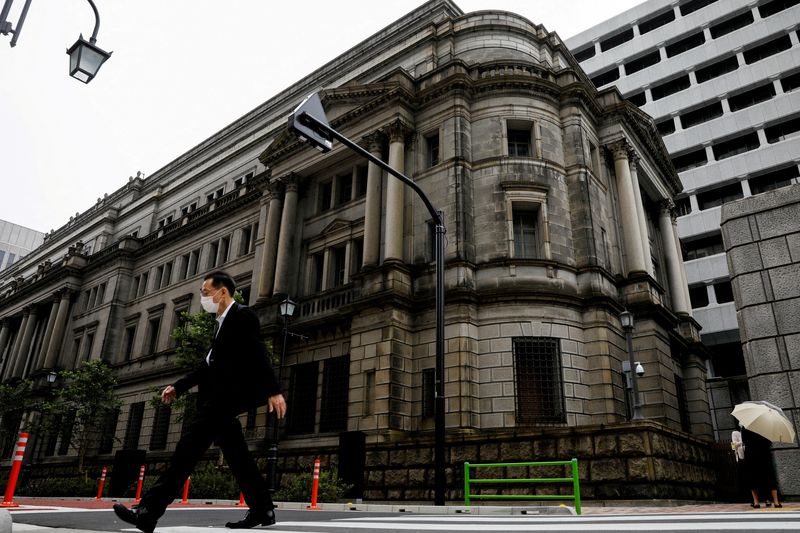As Bank of Japan switches gears, roaring dollar hits the skids By

© Reuters. FILE PHOTO: A man wearing a protective mask walks past the headquarters of Bank of Japan amid the coronavirus disease (COVID-19) outbreak in Tokyo, Japan, May 22, 2020. REUTERS/Kim Kyung-Hoon
By Amanda Cooper
LONDON (Reuters) – The dollar’s biggest bull run in 40 years may have finally come to a screeching halt, now that the world’s last dovish central bank – the Bank of Japan – has finally relaxed its iron grip on long-term interest rates.
The BOJ shocked markets on Tuesday with a surprise tweak to bond yield control, allowing long-term interest rates to rise more in a move aimed at easing some of the costs of prolonged monetary stimulus.
BOJ Governor Haruhiko Kuroda, who steps down in April, said this was a technical measure aimed at improving the way the bond market works and in no way was a form of monetary tightening.
The timing caught investors off guard, pushing the yen up roughly 4% against the dollar, its largest one-day gain in 24 years. The dollar was last down 3.9% at 131.60 yen. Benchmark Japanese 10-year yields to their highest in seven years – effectively doubling long-term borrowing costs.
The BOJ’s move will likely reduce demand for U.S. Treasuries, analysts said. Japan, the world’s largest non-U.S. holder of U.S. government debt, has reduced its load of Treasuries for the last several months, selling them to defend the yen that at one point lost about 25% of its value against the dollar and as hedging costs have skyrocketed.
The dollar has risen 9% this year, as the Federal Reserve has jacked up interest rates to combat inflation at 40-year highs. It has clocked the most gains against the yen, which has been weighed down by the BOJ’s policy of controlling longer-term yields.
As other central banks, from the Bank of England, to the European Central Bank, and the Reserve Bank of Australia, have raised their own rates, dollar bulls have run out of puff. Against a basket of major currencies, the U.S. currency is heading for its biggest quarterly loss since late 2010. But the dollar could, until now, count on its edge against the yen, to prolong its bull run.
Societe Generale (OTC:)’s head of FX strategy Kit Juckes said the dollar’s second-biggest run-up since February 1985 was effectively over.
“However we dress up the world, the Fed is crawling towards the end of its rate-hiking cycle,” he said. “The rate hikes are going to get smaller and smaller and eventually, there will be nothing and that will be the end of that story.”
The close relationship between Japanese monetary policy and U.S. Treasuries adds another twist to the story.
After the BOJ’s decision, U.S. 10-year Treasuries sold off, pushing yields higher by as much as 13 basis points to 3.71%. They were last up 10 bps on the day at 3.691%.
“A further reduction in demand from the world’s largest holder of Treasuries should add to volatility and exacerbate any potential duration sell-off in 2023,” Erik Nelson, macro strategist, at Wells Fargo …
Read More: As Bank of Japan switches gears, roaring dollar hits the skids By
